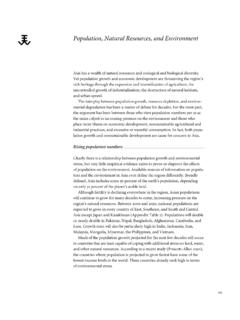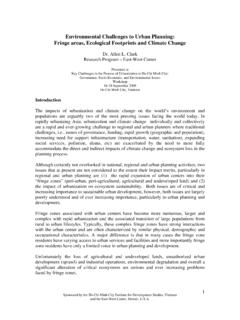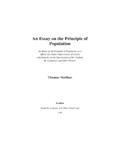Transcription of Asia’s Aging Population
1 asia s Aging PopulationAll across asia , the number of people age 65and above is expected to grow dramatically over the next 50years. For the region as a whole, the Population in this age group will increase by 314percent from 207million in 2000to 857million in 2050(Table 1). Facing an unprecedented pace of Population Aging ,Asian governments must tackle important policy challenges. How best can the needs of the elderly be met? Will current approaches to support the elderlyplace an undue burden on the younger generation? And are there dangers thatprograms for the elderly will undermine economic growth? These issues arealso being confronted in the West where Population Aging is more the process of Population Aging is occurring much more rapidly in Asiathan it did in Western countries, and it will occur in some Asian countries at a much earlier stage of economic 2000, the average age in asia was 29years.
2 An estimated 6percent of theregion s total Population were age 65and older, 30percent were under age 15,and 64percent were in the working-age group of 15to 64years (United Nations2001). Appendix Table 7gives the proportions in these age groups for asia ssubregions and countries. United Nations medium projections estimate that the proportion in the working-age group will be the same in 2050, at 64percent,but there will be a dramatic shift in the proportion of children and the elderly(Figure 1). The proportion under age 15will drop to 19percent, and the propor-tion 65and older will rise to 18percent. The average age in asia will be general, the countries of East asia are furthest along in the Population - Aging process, followed by Southeast asia and then South asia (AppendixOver the next 50 years, the numberof elderly men and women in asia will more than triple (Chiangmai,Thailand) Wisut Jaijagcome/East-West Center 83 Table 1.)
3 Projected growth of asia s elderly populationNumber of people PercentRegion orage 65 and above (1,000s)increasesubregion200020252050200 0 2050 Asia206,822456,303857,040314 East Asia114,729244,082393,802243 Southeast Asia24,33557,836128,958430 South Asia67,758154,385334,280393 Source:United Nations (2001). Notes:All data are based on the United Nations medium fertility variant. The analysis includesTaiwan. Table 7). The exceptions are Singapore in Southeast asia and Sri Lanka inSouth asia , where relatively large proportions of the Population are elderly, andMongolia in East asia , where the proportion elderly is still has the oldest Population in asia , with 17percent age 65and older, andthe most rapidly Aging Population in the world. The United Nations mediumscenario anticipates that 29percent of Japanese will be 65or older by 2025and 36percent will be 65or older by 2050.
4 Bangladesh, by contrast, has the youngestpopulation of any major country in the region, with 3percent 65or older in2000. But even Bangladesh and asia s other young populations will experiencerapid Population Aging during the coming decades. Bangladesh s 65-and-olderpopulation is projected to rise to 5percent in 2025and 11percent in 2050. Future trends for asia s elderlyMore will be in the oldest age , asia s elderly are concentratedprimarily in the younger segments of the old-age Population group. Over time,however, the greatest increases in Population will occur in the oldest agegroups. Of all Asians age 55and older, roughly one-half are now between theages of 55and 64, about one-third are between 65and 74, and not quite one-sixth are 75and above.
5 These proportions will remain fairly stable over the next25years, but over the following 25-year period the proportion in the oldest agegroup (75and above) is expected to increase substantially from 15percent in2000to 17percent in 2025and then up to 27percent in will be most countries of asia , as in the rest of the world, olderwomen outnumber older men, particularly in the oldest age groups. Today,among the Population age 55and above, there are about 90men in asia forevery 100women. Among those age 75and above, there are only about 70men84 The Future of Population in Asia10090807060504030201001950 196019701980 19902000 2010202020302040 2050 YearChildren (0 14)Elderly (65+)Working age (15 64)Figure 1. asia s age transition:Proportions of working-ageadults (age 15 64years), children(age 0 14years), and elderly (age 65+ years), 1950 2050 Source:United Nations (2001).
6 Percent of total populationAsia s Aging Population85for every 100women. This is a persistent feature of asia s Population that is notexpected to change much over the next will be , nearly everyone in asia has married, and very few have divorced. Thus, most of the elderly are living with a spouseor are widowed. As life expectancies rise, the proportion of the elderly who are widowed at any given age will decline sharply. Women will be especiallyaffected because they are much more likely than men to be widowed. Today,for example, just over one-half (52percent) of all South Korean women age 65to 69are widows. This proportion is expected to drop to 17percent in Thailand, 32percent of women in this age group are widowed today, alsoprojected to drop to 17percent in 2050.
7 Among men age 65to 69, only 8per-cent are widowers in South Korea and only 10percent in Thailand. Because the proportions of men widowed are already low, the decline will be more modest for men than for women. They will have fewer adult many Asian countries, the elderly havemore surviving adult children today than at any time in history, a consequenceof previous declines in infant and child mortality. In 1990, Korean women intheir sixties, for example, had children on average. With the de-cline in childbearing, however, elderly parents will be increasingly dependenton only one or two adult children. Women in Japan who turned 65between1995and 2000were the first Japanese women in the 20th century to have anaverage of only two surviving children (Feeney and Mason 2001).
8 Given lowlevels of childbearing in China (including Hong Kong), Japan, Singapore,South Korea, Taiwan, and Thailand, many elderly women in the future willhave even fewer than two surviving children. The illness, death, or estrange-ment of even a single adult child will threaten the viability of the traditionalfamily support system for the will retire economic development, workers everywhere in the world tend to retire at younger ages (Figure 2). In part, this reflects thegreater wealth of older workers. But it also reflects larger numbers who are sub-ject to mandatory retirement ages or retirement plans that penalize those whocontinue to work. Although older adults are much more likely to work in Asiathan in Europe or the United States, the proportion of all Asian elderly in thelabor force has already declined and is projected to decline further from 38percent of the Population 65and above in 1950to 25percent in 2000and 22percent in 2010.
9 The estimated median retirement age for men dropped from67in 1960to 63in 2000. Labor-force participation varies widely among specific subregions and countries. Forty-one percent of Japanese men age 55and above were still work-ing in 2000, projected to drop to 29percent in 2050. Labor-force participationis higher for Indian men in this age group and is projected to decline muchless from 46percent in 2000to 41percent in women in asia are much less likely to work than older men. In 2000,there were about 150working men age 55and above for every 100workingwomen. The preponderance of men in the work force is even larger in the oldest age groups. Among those 65and above, there are 250men in the laborforce for every options for an Aging regionEfforts to assure adequate support for asia s expanding elderly populationfocus on four approaches.
10 These are: (1) policies and program that enhance tra-ditional Asian systems of family support; (2) policy reform that encourages theelderly who are still capable to remain in the work force; (3) institutions andsystems that support high levels of personal saving; and (4) public programs,including pension schemes and national healthcare support most traditional Asian societies, the elderly live in extended, multigenerational households and rely on their adult children,their spouses, and other family members for material needs and personal the 1980s, more than three-quarters of the elderly in asia were livingwith children or family (World Bank 1994). During the 1990s, about two-thirdswere living with their adult children, ranging from about one-half in Kazakh-stan to more than four-fifths in Pakistan and Bangladesh (Bongaarts andZimmer 2001).









